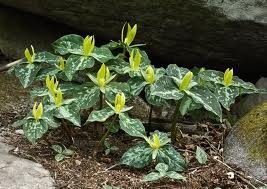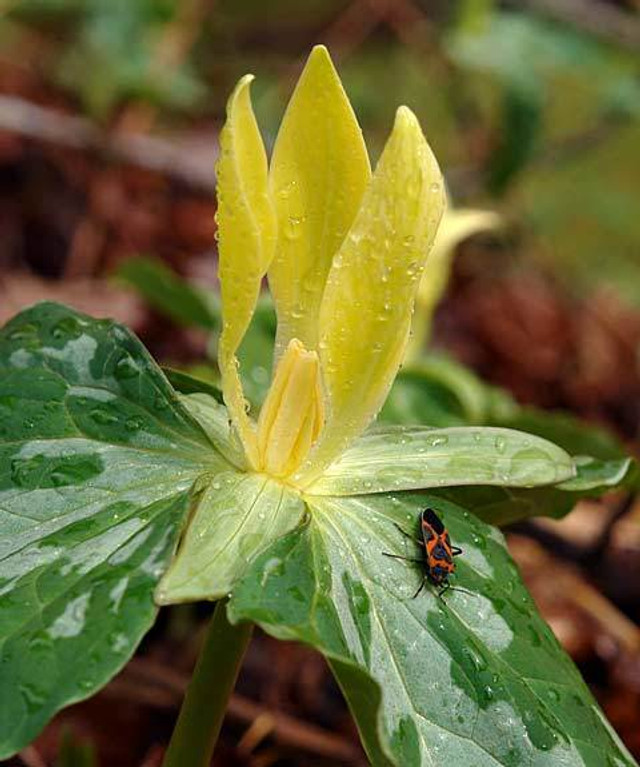Yellow Toadshade, also known as Yellow Trillium, is a fascinating herbaceous perennial native to the southeastern United States. Belonging to the Melanthiaceae family, this woodland plant thrives in USDA hardiness zones 4 through 8. It is a species that stands out due to its unique morphology and life cycle.
Unlike most plants, Trillium luteum does not have a true stem or regular leaves. What appears to be a stem is actually an extension of its rhizome, and its “leaves” are bracts that encircle the flower. This perennial enters its active growth phase in late winter, showcasing its bright yellow blooms before going dormant by mid-summer. Its ability to adapt and thrive in shaded woodland environments makes it a favorite among gardening enthusiasts who appreciate its subtle beauty and distinctive characteristics.
| Common name | Yellow Toadshade, Yellow Trillium |
| Botanical name | Trillium luteum |
| Family | Melanthiaceae |
| Species | luteum |
| Origin | Southeastern United States |
| Life cycle | Perennial |
| Plant type | Herbaceous Perennial |
| Hardiness zone | 4, 5, 6, 7, 8 |
| Sunlight | Deep shade |
| Maintenance | Medium |
| Soil condition | High Organic Matter |
| Soil ph | Neutral |
| Drainage | Well-Drained |
| Growth rate | Slow |
| Spacing | 12 in. – 3 ft. |
| Harvest time | Spring |
| Flowering period | Spring |
| Height | 8 in. – 1 ft. 6 in. |
| Flower color | Gold, Yellow |
| Leaf color | Gray, Silver |
| Fruit color | Green |
| Stem color | Green |
| Fruit type | Berry |
| Leaf benefit | Showy |
| Flower benefit | Fragrant |
| Garden style | Native Garden |
| Uses | Naturalized Area |
I. Appearance and Characteristics
Trillium luteum, the yellow trillium or yellow wakerobin, is a species of flowering plant in the bunchflower family Melanthiaceae. It is a member of the Trillium cuneatum complex, a closely related group of sessile-flowered trilliums. The species is endemic to the southeastern United States, especially in and around the Great Smoky Mountains of eastern Tennessee and western North Carolina.
Trillium luteum is a perennial, herbaceous, flowering plant that persists by means of an underground rhizome. Like all trilliums, it has a whorl of three bracts (leaves) and a single trimerous flower with three sepals, three petals, two whorls of three stamens each, and three carpels (fused into a single ovary with three stigmas). It has a sessile flower (no flower stalk), erect petals, and mottled leaves. It grows to 40 cm (16 in) tall by 30 cm (12 in) wide, with lemon yellow scented blooms.

The large stalkless triple leaves often have grey-green marbling on the surface. It flowers in April-May beneath the bare branches of deciduous trees. After flowering and setting seed it goes dormant in summer, before appearing again in late winter.
Though hardy down to −15 °C (5 °F), this plant requires a sheltered position with rich, moist leaf mould in a shaded, deciduous woodland setting which mimics its native habitat in North American broadleaf forests. It must be left undisturbed to grow into a large colony. It requires some experience to grow successfully, but nevertheless has gained the Royal Horticultural Society’s Award of Garden Merit.
II. How to Grow and Care
Sunlight
In nature, yellow trillium grows on forest floors, in valleys, or in rock cracks in middle- and high-altitude areas. It is a shade-loving plant. When grown in a garden, it needs a shaded environment, such as under trees or on the shady side of buildings to avoid harsh, direct sunlight. Blazing light exposure can cause it to wither.
Temperature
Yellow trillium originates from North America and East Asia and like cool, moist habitats. It grows well in an environment with a temperature range of 8 to 12 ℃ and doesn’t tolerate high temperatures. It likes moisture and is not drought-resistant, and it prefers air humidity at 75% – 90%.

Watering
Thriving in the understory of deciduous forests, yellow trillium is accustomed to the moist, well-drained soil conditions typical of its native woodland habitat. This species exhibits a preference for consistent moisture without being waterlogged, reflecting its natural balance between hydration and drainage.
Accordingly, yellow trillium benefits from watering every week to maintain this equilibrium. Given that yellow trillium is more commonly grown outdoors due to its affinity with forest-like environments, it’s important to consider mulching to retain soil moisture during dry spells, ensuring a mimicry of its natural setting for optimal growth.
Soil
Yellow trillium likes loose, fertile, moist, slightly acidic soil with good drainage. The ideal pH value range is 5.0-6.5, and shouldn’t exceed 7.3. If the soil is barren or has poor air permeability, you can improve it by mixing in a small amount of organic fertilizer.
Fertilizing

Fertilize yellow trillium in early spring with balanced, slow-release fertilizer, complemented midseason with high-phosphorus to boost flowering. Sprinkle granules at the recommended label rate around the drip line, avoiding direct contact with foliage. Seasonal changes govern less frequent, reduced-quantity applications. Use caution to prevent over-fertilization, which can harm yellow trillium’s delicate root system. Consistent feeding promotes vigorous growth and vibrant blooms.
Planting Instructions
Yellow trillium is not tolerant of transplanting, so the growing site needs to be chosen carefully. The planting site should be cool and shady, without nearby shallowly-rooted trees to compete with it for water. In the wild, the plant grows in humus-rich soils, so the planting soil also needs to be mixed with some humus.
Yellow trillium is best planted in the fall. Dig a 15 cm-deep planting pit, arrange and extend the plant’s roots neatly before putting it into the pit, cover the roots with soil, and press down lightly. It’s a good idea to cover the soil surface with organic matters like hay or shredded bark to retain moisture.
Propagation

Yellow trillium can propagate by sowing, but it takes 5-7 years after sowing for the plant to bloom. It can also propagate by plant division, which is usually performed after the flowering season. Carefully dig up its roots and divide the rhizome with a sharp knife, retaining at least 2 buds on each part. Bury these rhizomes back in the soil about 6 cm deep, and plant them 25 cm apart from one another. Plant division can quickly produce bloom-ready plants, but can also potentially cause the plants to die. Therefore, caution is advised in carrying out this method.
Transplanting
The ideal season for transplanting yellow trillium is during the cool fall or early spring (S2-S4), as these conditions facilitate root development. Locate it in part-to-full shade, ensuring well-drained, humus-rich soil. Kindly adopt slow and gentle handling during transplant, as yellow trillium may be delicate!
III. Harvesting and Storage

10-14 weeks after yellow trillium blooms, when the fruits turn brown, it’s time to harvest the seeds for sowing. Pick the fruits off the plant, squeeze lightly to crack them open, and find the ripe brown seeds inside. The seeds can be sown right away or placed in moist peat soil for refrigerated storage.
Find Where to Buy the Best Yellow Trillium (Trillium luteum)


















Leave a Reply